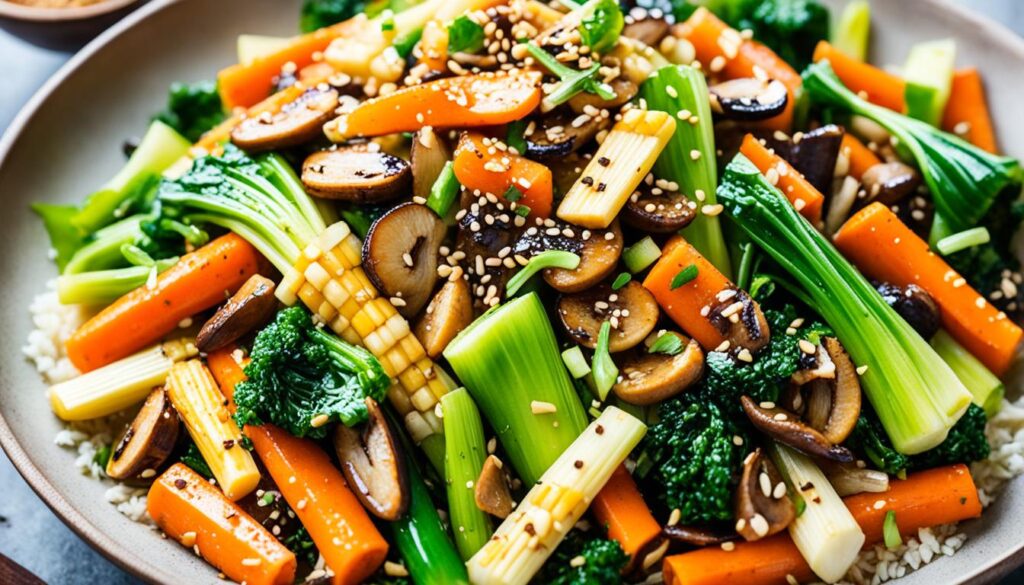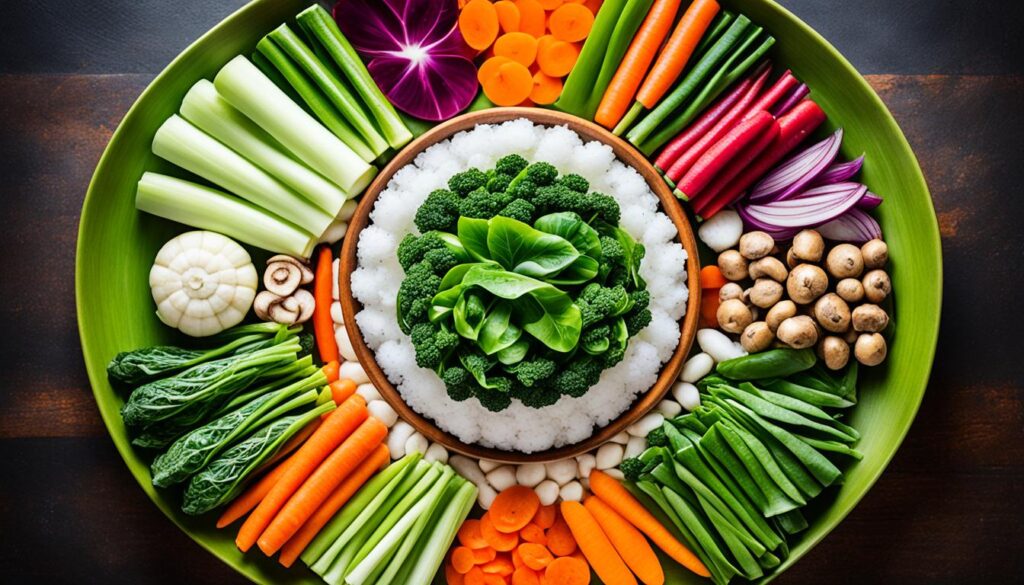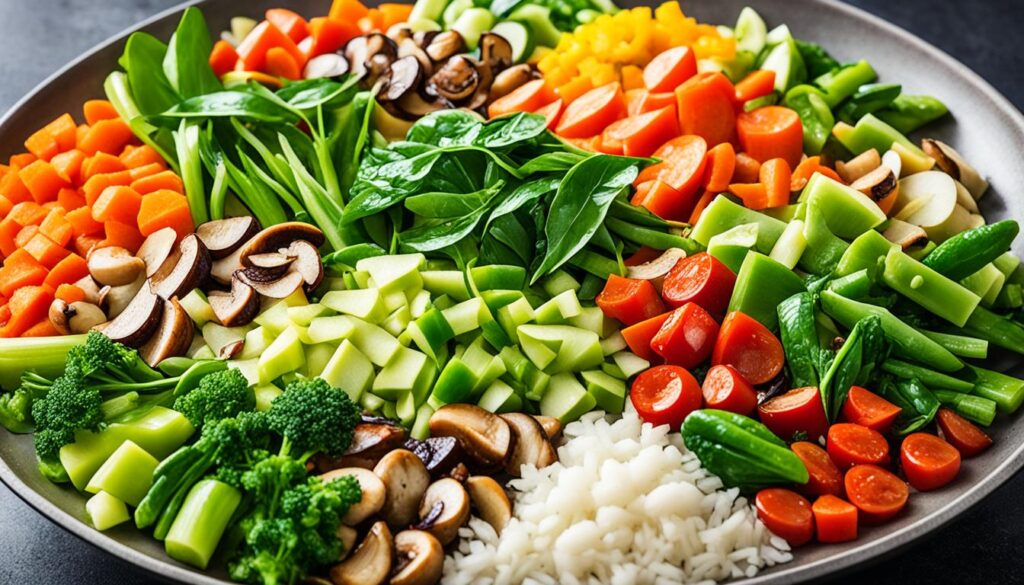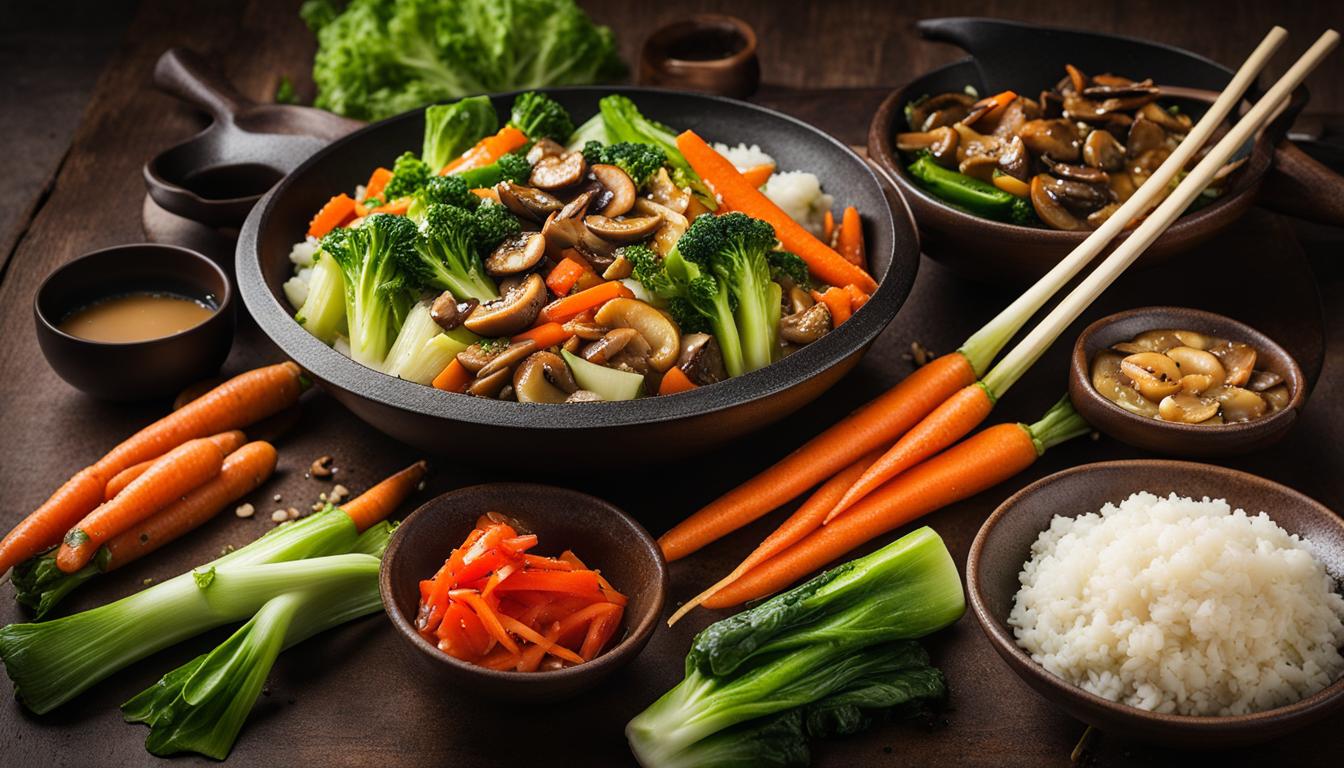Welcome to our delightful journey into the world of Buddha’s Delight! Have you ever wondered how to create a delicious and healthy Chinese vegetarian stir fry dish that will leave you craving for more? Look no further! In this article, we will guide you through the process of making an easy and authentic Buddha’s Delight recipe that is sure to please your taste buds.
Buddha’s Delight, a popular and authentic Chinese dish, is a delightfully flavorful combination of mixed vegetables and tofu in a savory sauce. This versatile stir fry is not only enjoyed by vegetarians but also by meat-eaters who are looking for a delicious and healthy option for their meal. With its vibrant flavors and beautiful array of vegetables, Buddha’s Delight is a dish that is sure to impress. Are you ready to embark on this culinary adventure with us?
Key Takeaways:
- Discover an easy and authentic recipe for Buddha’s Delight, a Chinese vegetarian stir fry dish.
- Learn how to create a flavorful and healthy meal in less than 30 minutes.
- Find out the benefits of incorporating soy products into your diet.
- Explore the versatility of Buddha’s Delight and customize it to your taste.
- Enjoy the delicious flavors and health benefits of Buddha’s Delight as part of your regular menu.
What is Buddha’s Delight?
Buddha’s Delight, also known as luo han zhai in Mandarin and lo han jai in Cantonese, is a popular vegetarian dish in both Chinese and Buddhist cuisine.
Traditionally consumed by Buddhist monks who follow a vegetarian diet, Buddha’s Delight has gained popularity as a healthy and flavorful option in Chinese restaurants worldwide.
The dish typically consists of a variety of vegetables and tofu, although the specific ingredients can vary. Its name, “Buddha’s Delight,” carries the connotation of a wholesome and satisfying dish that is both nourishing and delicious.
Ingredients for Buddha’s Delight
When it comes to making a delicious Buddha’s Delight stir fry, the key lies in the ingredients. To achieve authentic Chinese flavors, you’ll need a combination of mixed vegetables, tofu, and a savory sauce. Let’s take a closer look at each component:
Mixed Vegetables for Buddha’s Delight
Buddha’s Delight is a versatile dish that allows you to use a variety of vegetables based on your preference. Common choices include:
- Baby bok choy
- Carrots
- Broccoli
- Snow peas
- Shiitake mushrooms
- Cabbage
- Onions
- Snap peas
- Bell peppers
- Cauliflower
Feel free to experiment and personalize the dish by adding or substituting other vegetables that you enjoy.
Tofu for Buddha’s Delight
Tofu is an essential component of Buddha’s Delight and provides a good source of vegetarian protein. For this recipe, you’ll want to use silken tofu or firm tofu that has been drained and cubed. Baking the tofu before stir-frying gives it a delightful crispness that adds texture to the dish.
Savory Sauce for Buddha’s Delight
The savory sauce is what brings all the flavors together in Buddha’s Delight. To create an authentic taste, you’ll need the following sauce ingredients:
- Soy sauce
- Sesame oil
- Honey
- Ginger
- Garlic
These pantry staples provide the distinct and savory qualities that characterize Chinese cuisine.
Additionally, you can find complementary ingredients such as canned baby corn and bamboo shoots in the Asian aisle of most grocery stores. These ingredients add authenticity to the dish and enhance both flavor and texture.
To help you visualize the ingredients, here’s a table summarizing the key components of Buddha’s Delight:
| Ingredients |
|---|
| Mixed vegetables (e.g., baby bok choy, carrots, broccoli, snow peas) |
| Tofu (silken or firm) |
| Soy sauce |
| Sesame oil |
| Honey |
| Ginger |
| Garlic |
| Canned baby corn |
| Bamboo shoots |
With these ingredients, you’ll be able to create a flavorful and authentic Buddha’s Delight stir fry that satisfies your taste buds and brings the vibrant flavors of Chinese cuisine to your table.
How to Make Buddha’s Delight
Making Buddha’s Delight is relatively simple and can be done in a few easy steps. Follow our homemade Buddha’s Delight recipe to enjoy this delicious and healthy vegetarian dish.
Gather Your Ingredients
Before you begin, make sure you have all the necessary ingredients for your Buddha’s Delight:
- Extra firm tofu
- Mixed vegetables (baby bok choy, carrots, broccoli, snow peas, shiitake mushrooms, cabbage, onions, snap peas, bell peppers, and cauliflower)
- Baby corn and bamboo shoots (canned)
- Soy sauce
- Sesame oil
- Honey
- Ginger (fresh or powdered)
- Garlic (fresh or powdered)
- Sliced green onions (for garnish)
- Rice (optional, for serving)
Cooking Instructions
- Bake the tofu: Cut the extra firm tofu into cubes and arrange them on a baking sheet. Bake at 400°F (200°C) for 20-25 minutes or until lightly browned. This will give the tofu a crispy texture.
- Stir-fry the vegetables: In a large pan or wok, heat some oil over medium-high heat. Add the mixed vegetables, baby corn, and bamboo shoots. Stir-fry for 5-7 minutes until the vegetables are tender-crisp.
- Make the sauce: In a small bowl, whisk together soy sauce, sesame oil, honey, ginger, and garlic. Adjust the quantities according to your taste preferences.
- Add the tofu and sauce: Once the vegetables are cooked, add the baked tofu cubes to the pan. Pour the sauce over the vegetables and tofu. Stir well to coat everything evenly.
- Bring to a boil: Increase the heat to high and bring the mixture to a boil. Let it boil for a few minutes until the sauce thickens slightly.
- Finish and serve: Remove the pan from heat. Sprinkle sliced green onions on top as a garnish. Serve your Buddha’s Delight as a standalone dish or with rice if desired.

Note: Baking the tofu before stir-frying helps maintain its firmness and prevents it from crumbling during the cooking process.
Health Benefits of Buddha’s Delight
Buddha’s Delight offers numerous health benefits due to its nutritious ingredients. Incorporating soy products into the dish provides a vegetarian source of protein, which is essential for a balanced diet. Soyfoods are also environmentally friendly, requiring fewer natural resources to produce compared to other protein sources. Additionally, soy contains less saturated fat and is cholesterol-free, making it a healthy choice for those looking to reduce their intake of these harmful substances. Buddha’s Delight is also packed with other essential nutrients such as iron, fiber, calcium, and vitamins A and D, making it a nutrient-rich and wholesome dish.
Here are some key health benefits of Buddha’s Delight:
- Vegetarian Protein Source: Incorporating soy products into Buddha’s Delight provides a high-quality vegetarian protein source, offering all the essential amino acids needed for optimal health.
- Low Saturated Fat and Cholesterol-Free: Buddha’s Delight is a great choice for those following a low saturated fat diet or looking to reduce their cholesterol intake, as soy is naturally low in saturated fat and contains no cholesterol.
- Soyfoods Benefits: Consuming soyfoods, such as tofu in Buddha’s Delight, has been associated with various health benefits, such as heart health, bone health, and menopausal symptom relief.
- Environmentally Friendly Protein: Choosing soyfoods like Buddha’s Delight helps reduce environmental impact, as soy requires fewer natural resources and produces fewer greenhouse gas emissions compared to animal protein sources.
- Nutrient-Rich Dish: Buddha’s Delight is packed with essential nutrients, including iron, fiber, calcium, and vitamins A and D, contributing to overall health and well-being.
Quote:
“Buddha’s Delight is not only a delicious and wholesome dish, but it also offers numerous health benefits. From providing a vegetarian source of protein to being low in saturated fat and cholesterol-free, this nutrient-rich dish is a smart choice for those looking to nourish their bodies while enjoying flavorful cuisine.” – Health and Wellness Magazine
By incorporating Buddha’s Delight into your diet, you can enjoy a delicious and satisfying meal while reaping the numerous health benefits it offers. Whether you’re following a vegetarian lifestyle or simply looking to incorporate more plant-based options into your meals, Buddha’s Delight provides a flavorful and nutritious choice that promotes overall well-being.
Key Nutritional Information
| Nutrient | Amount per serving |
|---|---|
| Protein | 12g |
| Fiber | 6g |
| Iron | 10% of Daily Value |
| Calcium | 15% of Daily Value |
| Vitamin A | 20% of Daily Value |
| Vitamin D | 10% of Daily Value |

Image: Buddha’s Delight is a nutrient-rich dish that offers numerous health benefits.
Variations of Buddha’s Delight
One of the great aspects of Buddha’s Delight is its versatility, allowing for personalization and customization based on individual tastes and preferences. While the traditional recipe includes a variety of mixed vegetables and tofu, there is room for creativity and experimentation. Different vegetables can be added or substituted to create unique flavors and textures. Some popular variations include adding leeks, snow peas, bean sprouts, water chestnuts, and ginkgo nuts. By exploring different ingredient combinations and flavors, you can put your own creative spin on Buddha’s Delight and tailor it to suit your taste buds.
Customizing Flavors
When it comes to customizing the flavors of Buddha’s Delight, the possibilities are endless. By incorporating unique ingredients and seasonings, you can add depth and complexity to the dish. Here are some ideas to inspire your culinary creativity:
- Spicy Twist: Add a kick to your Buddha’s Delight by including diced chili peppers or chili flakes. This will give the dish a fiery heat that balances perfectly with the vegetables and tofu.
- Asian Fusion: Combine the flavors of Buddha’s Delight with other Asian cuisines. Add ingredients like soy sauce, sesame oil, and rice vinegar to give the dish a Japanese or Korean flair.
- Herbaceous Delight: Incorporate fresh herbs such as basil, cilantro, or mint to bring a burst of freshness and aroma to your Buddha’s Delight.
Creating Unique Textures
Buddha’s Delight is not only about the flavors but also about the textures. Adding unique ingredients can bring exciting textures to the dish. Here are some suggestions:
- Crispy Crunch: Toss in some water chestnuts or toasted almonds to add a satisfying crunch to your Buddha’s Delight. This contrast in textures will elevate the overall dining experience.
- Asian Greens: Expand your vegetable selection by adding Asian greens like gai lan (Chinese broccoli), yu choy, or choi sum. These greens have a slightly bitter taste and add a pleasant bite to the dish.
- Mushroom Magic: Experiment with different types of mushrooms such as enoki, oyster, or shimeji. These mushrooms provide an earthy flavor and a delightful chewiness.
Unique Ingredient Ideas
| Ingredient | Description |
|---|---|
| Leeks | Adds a mild onion flavor and a touch of sweetness. |
| Snow Peas | Brings a refreshing crunch and a subtle sweetness to the dish. |
| Bean Sprouts | Provides a fresh and crunchy texture. |
| Water Chestnuts | Delivers a satisfying crispy texture. |
| Ginkgo Nuts | Imparts a rich and nutty flavor to the Buddha’s Delight. |
By adding unique ingredients and experimenting with flavors and textures, you can create a personalized version of Buddha’s Delight that suits your taste preferences. Get creative in the kitchen and make this classic Chinese dish uniquely yours!

Tips for Cooking Buddha’s Delight
To achieve the best results when cooking Buddha’s Delight, it’s important to keep a few tips in mind.
Baking Tofu for Stir Fry
When preparing tofu for stir fry, try baking it beforehand. This technique helps achieve a firmer and crispier texture, adding a delightful crunch to your dish.
Vegetable Selection for Stir Fry
When selecting vegetables for your Buddha’s Delight stir fry, consider personal preference and availability. Aim for a variety of colors, textures, and flavors to create a visually appealing and well-rounded dish.
Tips for Sauce Consistency
To ensure that your sauce coats the vegetables and tofu evenly, pay attention to its consistency. You want it to be thick enough to cling to the ingredients, but not so thick that it becomes clumpy. Adjust the thickness by adding more cornstarch or water as needed.
By implementing these tips, you can enhance the overall taste and presentation of your Buddha’s Delight. Experiment with different techniques and ingredient combinations to make this classic Chinese dish your own masterpiece.
Serving Buddha’s Delight
When it comes to serving Buddha’s Delight, there are various options to consider. Whether you choose to enjoy it as a main dish or incorporate it into a larger meal, this versatile recipe can be customized to suit your preferences. Here are some ideas for accompaniments, garnishes, and pairings that will elevate your Buddha’s Delight to a restaurant-quality meal.
Pairing with Rice
One of the best ways to serve Buddha’s Delight is by pairing it with steamed rice. The fluffy texture and mild flavor of the rice complement the vibrant and savory flavors of the stir-fried vegetables and tofu. The combination provides a balanced and satisfying meal that is both filling and nutritious.
Accompaniments
To enhance the flavors and textures of Buddha’s Delight, consider serving it with some delicious accompaniments. Here are a few options:
- Spring Rolls: Crispy and filled with a mouthwatering combination of vegetables or tofu, spring rolls add a delightful crunch to your meal.
- Dumplings: Whether steamed or fried, dumplings are a popular choice to accompany Buddha’s Delight. Their savory fillings and soft wrappers make them a perfect addition to the meal.
- Side Salad: A fresh and crisp side salad can provide a refreshing contrast to the warm and savory Buddha’s Delight. Opt for a mix of greens, such as lettuce, cucumber, and carrots, and dress it with a light vinaigrette.
Garnishes
To add a touch of freshness and vibrancy, garnishes can be sprinkled over Buddha’s Delight. Consider the following options:
- Chopped Cilantro: Sprinkle some freshly chopped cilantro over the dish to add a burst of herbaceous flavor.
- Sesame Seeds: Toasted sesame seeds provide a nutty and aromatic taste that complements the flavors of Buddha’s Delight.
- Squeeze of Lime Juice: A squeeze of lime juice adds a tangy and citrusy element that brightens up the dish.
By incorporating these accompaniments and garnishes, you can enhance the visual appeal and taste of Buddha’s Delight, taking it to another level of enjoyment.
Serving Ideas for Buddha’s Delight
| Pairing | Accompaniments | Garnishes |
|---|---|---|
| Steamed Rice | Spring Rolls | Chopped Cilantro |
| Dumplings | Sesame Seeds | |
| Side Salad | Squeeze of Lime Juice |
Buddha’s Delight as a Celebration Dish
Buddha’s Delight holds great significance in Chinese culture, particularly during celebrations such as Chinese New Year. This traditional holiday dish is often served on the first day of the lunar calendar, symbolizing self-purification, good luck, and a fresh start.
The wholesome and nourishing nature of Buddha’s Delight makes it a popular choice for Buddhist celebrations as well. This festive dish embodies the values of balance, harmony, and compassion that are central to the Buddhist philosophy. Its inclusion in celebratory meals honors cultural traditions and brings a sense of auspiciousness to the occasion.
By incorporating Buddha’s Delight into your festive meals, you can not only enjoy a flavorful and nutritious vegetarian dish but also pay homage to age-old customs and beliefs. This symbolic and delicious dish adds a touch of authenticity and cultural connection to your celebration, making it a memorable and meaningful experience for everyone.
Image: Buddha’s Delight, a vegetarian dish traditionally served during Chinese New Year and Buddhist celebrations.
Make Buddha’s Delight a Regular Addition to Your Menu
Adding Buddha’s Delight to our regular menu can have numerous benefits. By incorporating more vegetarian meals into our diet, we can increase our intake of essential nutrients, enjoy the health benefits of soy foods, and reduce our consumption of saturated fat and cholesterol.
Making the choice to have at least one meatless dinner per week can also contribute to a more balanced and wholesome diet. With its versatility, ease of preparation, and delicious flavors, Buddha’s Delight can become a regular and enjoyable addition to our meal rotation.
| Benefits of Making Buddha’s Delight a Regular Dish |
|---|
| Increase intake of essential nutrients |
| Enjoy the health benefits of soy foods |
| Reduce consumption of saturated fat and cholesterol |
| Contribute to a more balanced and wholesome diet |
By incorporating Buddha’s Delight into our regular meals, we can enjoy the flavors and health benefits of this delicious vegetarian dish. Its combination of mixed vegetables and tofu provides a balanced and nutritious meal option. Additionally, the incorporation of soy foods adds protein and other essential nutrients to our diet.
Making Buddha’s Delight a regular dish also allows us to explore the versatility of vegetarian cuisine. We can experiment with different vegetables, sauces, and seasonings to create new variations of the dish that suit our taste preferences.
“By making Buddha’s Delight a regular addition to our menu, we can enjoy the benefits of a vegetarian diet while savoring the delicious flavors of this wholesome dish.” –
Conclusion
Buddha’s Delight is a delightful and wholesome Chinese vegetarian stir fry recipe that combines delicious flavors with numerous health benefits. With its versatile combination of savory sauce, mixed vegetables, and tofu, it satisfies both the taste buds and the body’s nutritional needs. Whether you follow a vegetarian diet or not, this dish can be enjoyed by everyone, offering a delicious and satisfying meal option.
One of the key ingredients in Buddha’s Delight is soy products, which are known for their high protein content and environmental sustainability. By incorporating soyfoods into the recipe, you can increase your protein intake and contribute to a healthier diet. In addition, Buddha’s Delight can be customized to suit your preferences by adding or substituting different vegetables, allowing you to create a unique flavor profile that suits your taste.
Whether you choose to serve Buddha’s Delight as a celebration dish during festivals or simply as a regular addition to your menu, it is a choice that offers both symbolic significance and culinary enjoyment. With its rich flavors, nutrient-rich ingredients, and easy preparation, Buddha’s Delight is a wholesome and delicious dish that can elevate your dining experience and contribute to your overall well-being.
In conclusion, we invite you to try this authentic Chinese vegetarian stir fry recipe and experience the deliciousness and health benefits of Buddha’s Delight for yourself. With its versatility and nutritional value, it is a dish that is sure to become a favorite among both vegetarians and meat-eaters alike.
